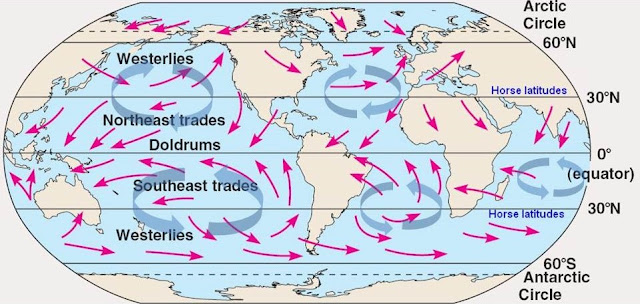A gyre is a rotating surface current. There are five major basin-wide gyres on the planet: the North and South Atlantic Subtropical Gyres; the North and South Pacific Subtropical Gyres; and the Indian Subtropical Gyre. They are all wind-driven. Though some like the North Atlantic gyre form part of the global thermohaline circulation, all would slowly spin down and stop without the constant input of momentum from the wind, which is driven by the sun.
The five major ocean gyres.
It has been estimated that the North Atlantic gyre, including its western arc the Gulf Stream, would shut down in about ten years were winds removed. (Fortunately this isn’t at all likely to happen, no matter what else a warming planet throws at us.) The dominant wind patterns of the planet create and maintain these surface circulation systems. Variations in wind intensity and storm activity certainly affect, but do not stop them.
Ocean gyres and global wind patterns.
Even the hypothesized influence of cold, fresh meltwater
from Canada and Greenland will not shut the North Atlantic gyre down. Ice loss
from the far north will certainly affect wind patterns but will not completely
disrupt them. The major influences: incoming radiation from the sun; the
thermal imbalance between equator and poles; and the presence of the continents,
will remain. What the freshwater influx could potentially do, however, is push
the northern arc of the North Atlantic gyre farther south, compressing it, and
limiting the transfer of heat to the north.
There are smaller gyres within the minor ocean basins, such
as the Mediterranean, the Arctic Ocean (sometimes called the Arctic
Mediterranean), and the Gulf of Mexico. These circulation patterns are subject
to greater variation, being driven by smaller-scale wind flows.
Tomorrow: the Pacific (and other) garbage patch(es).
Be brave, and be well.







No comments:
Post a Comment